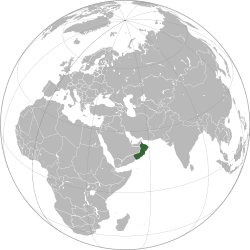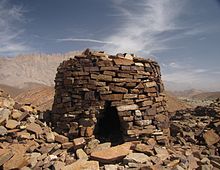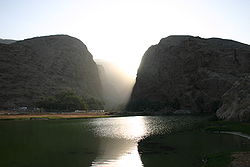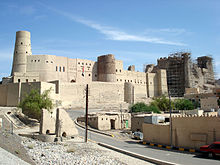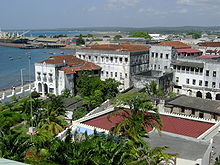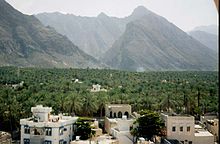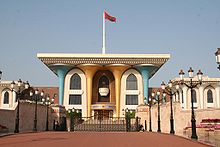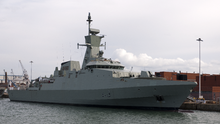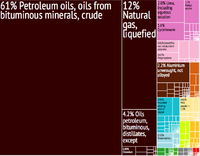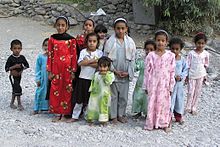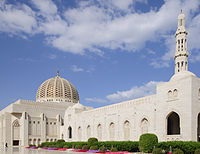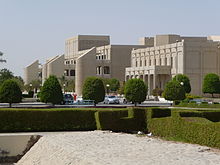
Oman
About this schools Wikipedia selection
SOS Children made this Wikipedia selection alongside other schools resources. SOS Children works in 45 African countries; can you help a child in Africa?
| Sultanate of Oman سلطنة عُمان
Salṭanat ʻUmān |
||||||
|---|---|---|---|---|---|---|
|
||||||
| Anthem: Nashid as-Salaam as-Sultani National anthem of Oman |
||||||
|
|
||||||
| Capital and largest city |
Muscat 23°36′N 58°33′E |
|||||
| Official languages | Arabic | |||||
| Demonym | Omani | |||||
| Government | Unitary Islamic state under absolute monarchy |
|||||
| - | Sultan | Qaboos bin Said al Said | ||||
| - | Deputy Prime Minister | Fahd bin Mahmoud al Said | ||||
| Legislature | none | |||||
| Establishment | ||||||
| - | The Azd tribe migration | Late 2nd century | ||||
| - | Imamate established | 751 | ||||
| Area | ||||||
| - | Total | 309,501 km2 ( 70th) 119,498 sq mi |
||||
| - | Water (%) | negligible | ||||
| Population | ||||||
| - | 2010 census | 2,773,479 | ||||
| - | Density | 9.2/km2 ( 220th) 23.8/sq mi |
||||
| GDP ( PPP) | 2011 estimate | |||||
| - | Total | $81.767 billion | ||||
| - | Per capita | $26,519 | ||||
| GDP (nominal) | 2011 estimate | |||||
| - | Total | $71.888 billion | ||||
| - | Per capita | $23,315 | ||||
| HDI (2013) | high · 84th |
|||||
| Currency | Rial ( OMR) |
|||||
| Time zone | GST ( UTC+4) | |||||
| - | Summer ( DST) | ( UTC+4) | ||||
| Drives on the | right | |||||
| Calling code | +968 | |||||
| ISO 3166 code | OM | |||||
| Internet TLD | .om | |||||
Oman ( / oʊ ˈ m ɑː n / oh-MAAN; Arabic: عمان ʻUmān), officially called the Sultanate of Oman (Arabic: سلطنة عُمان Salṭanat ʻUmān), is an Arab state in southwest Asia on the southeast coast of the Arabian Peninsula. It has a strategically important position at the mouth of the Persian Gulf. It is bordered by the United Arab Emirates (UAE) to the northwest, Saudi Arabia to the west, and Yemen to the southwest and also shares a marine border with Iran. The coast is formed by the Arabian Sea on the southeast and the Gulf of Oman on the northeast. The Madha and Musandam enclaves are surrounded by the UAE on their land borders, with the Strait of Hormuz and Gulf of Oman forming Musandam's coastal boundaries.
From the 17th century, Oman had its own empire, and vied with Portugal and Britain for influence in the Persian Gulf and Indian Ocean. At its peak in the 19th century, Omani influence or control extended across the Strait of Hormuz to Iran, and modern day Pakistan, and as far south as Zanzibar. As its power declined in the 20th century, the sultanate came under heavy influence from the United Kingdom, though Oman was never formally part of the British Empire, or a British protectorate. Oman has long-standing military and political ties with the United Kingdom and the United States, although it maintains an independent foreign policy.
Oman is an absolute monarchy in which the Sultan of Oman exercises ultimate authority, but its parliament has some legislative and oversight powers. In November 2010, the United Nations Development Programme (UNDP) listed Oman, from among 135 countries worldwide, as the nation most-improved during the preceding 40 years. According to international indices, Oman is one of the most developed and stable countries in the Arab world.
As with other Arab States of the Persian Gulf, oil is the mainstay of the economy, providing a large proportion of GDP, although compared to its neighbours Oman is a modest producer. Agriculture and fishing are also important sources of income. A diversification drive includes tourism; the policy of Omanisation aims to replace expatriate workers with locals.
History
Prehistory
At Aybut Al Auwal in the Dhofar region of Oman a site was discovered in 2011 containing more than 100 surface scatters of stone tools belonging to a regionally-specific African lithic industry - the late Nubian Complex - known previously only from the northeast and Horn of Africa. Two optically stimulated luminescence age estimates place the Arabian Nubian Complex at 106,000 years old. This supports the proposition that early human populations moved from Africa into Arabia during the Late Pleistocene.
Dereaze, located in the city of Ibri, is the oldest known human settlement in the area, dating back as many as 8,000 years to the late Stone Age. Archaeological remains have been discovered here from the Stone Age and the Bronze Age; findings have included stone implements, animal bones, shells and fire hearths, with the later dating back to 7615 BC as the oldest signs of human settlement in the area. Other discoveries include hand-molded pottery bearing distinguishing pre-Bronze Age marks, heavy flint implements, pointed tools and scrapers.
On a mountain rock-face in the same district, animal drawings have been discovered. Similar drawings have also been found in the Wadi Sahtan and Wadi Bani Kharus areas of Rustaq, consisting of human figures carrying weapons and being confronted by wild animals. Siwan in Haima is another Stone Age location and some of the archaeologists have found arrowheads, knives, chisels and circular stones which may have been used to hunt animals.
Ancient history
Sumerian tablets refer to a country called Magan or Makan, a name believed to refer to Oman's ancient copper mines. Mazoon, another name used for the region, is derived from the word muzn, which means heavy clouds which carry abundant water. The present-day name of the country, Oman, is believed to originate from the Arab tribes who migrated to its territory from the Uman region of Yemen; many such tribes settled in Oman, making a living by fishing, herding or stock breeding, and many present day Omani families are able to trace their ancestral roots to other parts of Arabia.
From the 6th century BC to the arrival of Islam in the 7th century AD, Oman was controlled and/or influenced by three Persian dynasties, the Achaemenids, Parthians and Sassanids. In the 6th century BC, the Achaemenids exerted a strong degree of control over the Omani peninsula, most likely ruling from a coastal centre such as Sohar. By about 250 BC, the Parthian dynasty had brought the Persian Gulf under their control and extended their influence as far as Oman, establishing garrisons in Oman to help control the trade routes in the Persian Gulf. In the 3rd century AD, the Sassanids succeeded the Parthians and held the area until the rise of Islam four centuries later.
Arrival of Islam
Omanis were among the first people to come in contact with and accept Islam. The conversion of the Omanis is usually ascribed to Amr ibn al-As, who was sent by Muhammad around 630 AD to invite Jayfar and 'Abd, the joint rulers of Oman at that time, to accept the faith. In submitting to Islam, Oman became an Ibadhi state, ruled by an elected leader, the Imam.
During the early years of the Islamic mission, Oman played a major role in the Wars of Apostasy that occurred after the death of Muhammad, and also took part in the great Islamic conquests by land and sea in Iraq, Persia and beyond. Oman's most prominent role in this respect was through its extensive trading and seafaring activities in East Africa and the Far East, particularly during the 19th century, when it propagated Islam to many of East Africa's coastal regions, certain areas of Central Africa, India, Southeast Asia and China. After its submission to Islam, Oman was ruled by Umayyads between 661–750, Abbasids between 750–931, 932–933 and 934–967, Qarmatians between 931–932 and 933–934, Buyids between 967–1053, and the Seljuks of Kirman between 1053–1154.
Portuguese colonization
A decade following Vasco de Gama's successful voyage around the Cape of Good Hope and to India in 1497-98, the Portuguese explorers arrived in Oman and occupied Muscat for a 143-year period, between 1507 and 1650, where their fortress still remains. In need of an outpost to protect their sea lanes, the Portuguese built up and fortified the city, where remnants of their colonial architectural style still remain. The Ottoman Navy took over the port of Oman in 1522 during the fight for control over the Persian Gulf.
Rebellious tribes eventually drove out the Portuguese, but they were pushed out themselves about a century later, in 1741, by the leader of a Yemeni tribe leading a massive army from various allied tribes, beginning the current line of ruling sultans. Excepting a brief Persian invasion in the late 1740s, Oman has been self-governing ever since.
No foreign power controlled the entirety of what is now Oman. The majority of the territory was always ruled by tribes, with colonial control contained to a few strategic port cities. Oman, as it exists now was never under the total sway of European colonization.
18th and 19th century
In the 1690s, Saif bin Sultan, the Imam of Oman, pressed down the East African coast. A major obstacle to his progress was Fort Jesus, housing the garrison of a Portuguese settlement at Mombasa. After a two-year siege, the fort fell to bin Sultan in 1698. Thereafter the Omanis easily ejected the Portuguese from Zanzibar and from all other coastal regions north of Mozambique, with the aid of the Somali Ajuuraan State. The Persians invaded Oman in 1737. They were driven out in 1749 when the Al Said dynasty came to power. They continue to rule to this day.
Zanzibar was a valuable property as the main slave market of the East African coast, and became an increasingly important part of the Omani empire, a fact reflected by the decision of the 19th century Sultan of Oman, Sa'id ibn Sultan, to make it his main place of residence in 1837. Sa'id built impressive palaces and gardens in Zanzibar. Rivalry between his two sons was resolved, with the help of forceful British diplomacy, when one of them, Majid, succeeded to Zanzibar and to the many regions claimed by the family on the East African coast. The other son, Thuwaini, inherited Muscat and Oman.
A History of Omani presence is also known in Comoros archipelago in the Indian ocean, which led to influences in Comorian culture from the clothing, to the wedding ceremonies.
In 1783, Oman's Saiad Sultan, defeated ruler of Muscat, was granted sovereignty over Gwadar, a coastal city located in the Makran region of what is now the far southwestern corner of Pakistan, near the present-day border of Iran and at the mouth of the Gulf of Oman. After regaining control of Muscat, this sovereignty was continued (via an appointed wali, "governor") and close relations were maintained with the Emirs of Sindh. Another point of view is that In the middle of the eighteenth century, Mir Nasir Khan captured Gwadar and its surrounding areas after defeating the Gichkis Tribes and included it in the Kalat Khanate. However, realizing that maintaining control of the area will be difficult without the support of the Gichkis, Mir Nasir entered into an agreement with the local Gichki Chief, which allowed the Gichkis to maintain administrative control of the area, in return for furnishing half the collected revenues to Kalat. This arrangement continued till 1783, when Saiad Sultan fell out with his brother, the ruler of Muscat, and asked for help. Mir Nasir Khan handed over Gwadar, as part of his share of revenues, to Saiad Sultan for his maintenance with the understanding that the area be returned to Kalat, when Saiad Sultan acquires the throne. Saiad Sultan ascended to the throne of Muscat in 1797 but never returned Gwadar enclave to Kalat. The ensuing struggle between the heirs of the Sultan and Khan of Kalat, for possession of Gwadar, allowed the British to intervene. The British after extracting concessions from the Sultan for the use of the area facilitated Muscat to retain Gwadar. Later on, the British tried to twist the history by claiming that the area was permanently gifted to the Sultan by Mir Nasir, however, local accounts and the declassified documents of that time refute this claim.
The Hajar Mountains, of which the Jebel Akhdar is a part, separate the country into two distinct regions: the interior, known as Oman, and the coastal area dominated by the capital, Muscat. In 1913, control of the country split. The interior was ruled by Ibadite imams and the coastal areas by the sultan. Under the terms of the British-brokered Treaty of Seeb of 1920, the sultan recognised the autonomy of the interior. The Sultan of Muscat would be responsible for the external affairs of Oman.
Reign of Sultan Said
The rule of Sultan Said bin Taimur was characterised by a feudal and isolationist approach.
Imam Ghalib Bin Ali was the elected Imam of the Imamate of Oman in May 1954. Relations between the Sultan of Muscat, Said bin Taimur, and Imam Ghalib were ruptured over a dispute concerning the right to grant oil concessions. A subsidiary of the Iraq Petroleum Company was intensely interested in some promising geological formations near Fahud. Under the terms of the 1920 treaty of Seeb, the Sultan claimed all dealings with the oil company as his prerogative. The Imam, on the other hand, claimed that since the oil was in his territory, anything dealing with it was an internal matter.
In December 1955, Sultan Said bin Taimur sent troops of the Muscat and Oman Field Force to occupy the main centres in Oman, including Nizwa, the capital of the Imamate of Oman, and Ibri. Imam Ghalib bin Ali along with his younger brother Talib bin Ali Al Hinai, led the Imamate of Oman in the Jebel Akhdar War against Sultan Said bin Taimur's attack on his lands. In July 1957, the Sultan's forces were withdrawing, but they were repeatedly ambushed, sustaining heavy casualties. Sultan Said bin Taimur, however, with the intervention of infantry (two companies of the Cameronians) and armoured car detachments from the British Army and aircraft of the RAF was able to suppress the rebellion. Talib's forces retreated to the inaccessible Jebel Akhdar.
Colonel David Smiley, who had been seconded to organize the Sultan's Armed Forces, managed to isolate the mountain in autumn 1958 and found a route to the plateau from Wadi Bani Kharu. On 27 January 1959, they occupied the mountain in a surprise operation. Ghalib, Talib and Sulaiman managed to escape to Saudi Arabia, where the imamate's cause was promoted until the 1970s. The Treaty of Seeb was terminated and the autonomous Imamate of Oman abolished giving way to the present day Sultanate.
In 1955, Makran acceded to Pakistan and was made a district – although Gwadar, at the time, was not included in Makran. On 8 September 1958, Pakistan purchased the Gwadar enclave from Oman for $3 million. Gwadar then became a tehsil in the Makran district.
Oil reserves were discovered in 1964 and extraction began in 1967. In the Dhofar Rebellion, which began in 1965, leftist forces were pitted against government troops. As the rebellion threatened to overthrow the Sultan's rule in Dhofar, Sultan Said bin Taimur was deposed in a bloodless coup (1970) by his son Qaboos bin Said, who expanded Sultan of Oman's Armed Forces, modernised the state's administration and introduced social reforms. The uprising was finally put down in 1975 with the help of forces from Iran, Jordan, Pakistan and the British Royal Air Force and Special Air Service.
Reign of Sultan Qaboos
After deposing his father in 1970, Sultan Qaboos opened up the country, embarked on economic reforms and followed a policy of modernisation by spending on health, education and welfare. In 1981 Oman became a founding member of the six-nation Gulf Cooperation Council.
It was some time before political reforms were introduced. However, in 1997 Sultan Qaboos decreed that women could stand for election to - and vote for - the majlis al-shura or Consultative Council. Two women were duly elected to the body. In 2002, voting rights were extended to all citizens over the age of 21. Voters were previously chosen from among tribal leaders, intellectuals and businessmen. The first elections to the Consultative Council, the majlis al-shura, in which all citizens over the age of 21 could vote were held in 2003. In 2004, the Sultan appointed Oman's first female minister with portfolio.
There was, however, little change to the actual political make-up of the government and the Sultan continued to rule by decree. Nearly 100 suspected Islamists were arrested in 2005 and 31 people were convicted of trying to overthrow the government. They were, however, pardoned in June.
Unrest has been inspired by the Arab Spring groundswell of political dissent in the region. Protests began in January 2011, with protestors demanding political reforms and jobs. They were dispersed by riot police in February 2011. Sultan Qaboos reacted by promising jobs and benefits. In October 2011, elections were held to the Consultative Council, for which Sultan Qaboos promised greater powers. The following year, the government began a crackdown on Internet criticism. In September 2012, trials began of 'activists' accused of posting "abusive and provocative" criticism of the government online. Six were given jail terms of 12–18 months and fines of around $2,500 each.
Geography
Oman lies between latitudes 16° and 28° N, and longitudes 52° and 60° E.
A vast gravel desert plain covers most of central Oman, with mountain ranges along the north ( Al Hajar Mountains) and southeast coast, where the country's main cities are also located: the capital city Muscat, Sohar and Sur in the north, and Salalah in the south. Oman's climate is hot and dry in the interior and humid along the coast. During past epochs Oman was covered by ocean, witnessed by the large numbers of fossilized shells existing in areas of the desert away from the modern coastline.
The peninsula of Musandam (Musandem) exclave, which has a strategic location on the Strait of Hormuz, is separated from the rest of Oman by the United Arab Emirates. The series of small towns known collectively as Dibba are the gateway to the Musandam peninsula on land and the fishing villages of Musandam by sea, with boats available for hire at Khasab for trips into the Musandam peninsula by sea.
Oman's other exclave, inside UAE territory, known as Madha, located halfway between the Musandam Peninsula and the main body of Oman, is part of the Musandam governorate, covering approximately 75 km2 (29 sq mi). Madha's boundary was settled in 1969, with the north-east corner of Madha barely 10 m (32.8 ft) from the Fujairah road. Within the Madha exclave is a UAE enclave called Nahwa, belonging to the Emirate of Sharjah, situated about 8 km (5 mi) along a dirt track west of the town of New Madha, consisting of about forty houses with a clinic and telephone exchange.
The central desert of Oman is an important source of meteorites for scientific analysis.
Climate
Oman has a hot climate and very little rainfall. Annual rainfall in Muscat averages 100 mm (3.9 in), falling mostly in January. The Dhofar Mountains area receives seasonal rainfall (from late June to late September) as a result of the monsoon winds from the Indian Ocean saturated with cool moisture and heavy fog. The mountain areas receive more plentiful rainfall, and annual rainfall on the higher parts of the Jabal Akhdar probably exceeds 400 mm (15.7 in). Some parts of the coast, particularly near the island of Masirah, sometimes receive no rain at all within the course of a year. The climate generally is very hot, with temperatures reaching around 50 °C (122.0 °F) (peak) in the hot season, from May to September.
Flora and fauna
Desert shrub and desert grass, common to southern Arabia, are found, but vegetation is sparse in the interior plateau, which is largely gravel desert.
The greater monsoon rainfall in Dhofar and the mountains makes the growth there more luxuriant during summer; coconut palms grow plentifully in the coastal plains of Dhofar and frankincense is produced in the hills, with abundant oleander and varieties of acacia.
The Al Hajar Mountains are a distinct ecoregion, the highest points in eastern Arabia with wildlife including the Arabian tahr.
Indigenous mammals include the leopard, hyena, fox, wolf, hare, oryx, and ibex. Birds include the vulture, eagle, stork, bustard, Arabian partridge, bee eater, falcon, and sunbird. In 2001, Oman had nine endangered species of mammals and five endangered types of birds and nineteen threatened plant species. Decrees have been passed to protect endangered species, including the Arabian leopard, Arabian Oryx, Mountain gazelle, Goitered Gazelle, Arabian tahr, Green sea turtle, Hawksbill Turtle and Olive ridley turtle. However, the Oman Arabian Oryx sanctuary is the first site ever to be deleted from UNESCO's World Heritage List due to the government's decision to reduce the site to 10% of its former size so that the remainder could be opened to oil prospectors.
Environment
Drought and limited rainfall contribute to shortages in the nation's water supply, so maintaining an adequate supply of water for agricultural and domestic use is one of Oman's most pressing environmental problems, with limited renewable water resources; 94% of available water is used in farming and 2% for industrial activity, with the majority sourced from fossil water in the desert areas and spring water in hills and mountains. Drinking water is available throughout the country, either piped or delivered.
The soil in coastal plains, such as Salalah, have shown increased levels of salinity, due to over exploitation of ground water and encroachment by seawater in the water table. Pollution of beaches and other coastal areas by oil tanker traffic through the Strait of Hormuz and Gulf of Oman is also a persistent risk.
Politics
Oman is an absolute monarchy in which all legislative, executive, and judiciary power ultimately rests in the hands of the hereditary sultan, and in which the system of laws is based firmly on Islamic sharia. Freedom House has routinely rated the country "Not Free".
The Omani legislature is the bicameral Council of Oman, consisting of an upper chamber, the Council of State (Majlis ad-Dawlah) and a lower chamber, the Consultative Council (Majlis ash-Shoura). Political parties are banned.
The upper chamber has 71 members, appointed by the Sultan from among prominent Omanis; it has only advisory powers. The 84 members of the Consultative Council are elected by popular vote to serve four-year terms, but the Sultan makes the final selections and can negotiate the election results. The members are appointed for three-year terms, which may be renewed once. The last elections were held on 15 October 2011.
Sultan Qaboos bin Said is the de facto prime minister and also controls the foreign affairs and defence portfolios. The sultan has absolute power and issues laws by decree. He is the longest-serving ruler in the Middle East.
Legal system
The judiciary branch is subordinate to the sultan and the Ministry of Justice. Sharia (Islamic law) is the source of all legislation, and Sharia Court Departments within the civil court system are responsible for family-law matters, such as divorce and inheritance. In some rural areas, tribal laws and customs are frequently used to settle disputes.
The Basic Statute of the State is the cornerstone of the Omani legal system and it operates as a constitution for the country. The Basic Statute was issued in the year 1996 and thus far has only been amended once, in 2011, as a response to protests.
The administration of justice is highly personalised, with limited due process protections, especially in political and security-related cases. A 2012 report by Bertelsmann Stiftung declared that while "Oman's legal code theoretically protects civil liberties and personal freedoms, both are regularly ignored by the regime. Oman, therefore, cannot be considered free."
Foreign policy
Since 1970, Oman has pursued a moderate foreign policy and expanded its diplomatic relations dramatically. Oman is among the very few Arab countries that have maintained friendly ties with Iran. WikiLeaks disclosed US diplomatic cables which say that Oman helped free British sailors captured by Iran's navy in 2007. The same cables also portray the Omani government as wishing to maintain cordial relations with Iran and as having continuously turned down US diplomats requesting Oman to take a sterner stance against Iran.
Military
Oman's military manpower totalled 44,100 in 2006, including 25,000 men in the army, 4,200 sailors in the navy, and an air force with 4,100 personnel. The Royal Household maintained 5,000 Guards, 1,000 in Special Forces, 150 sailors in the Royal Yacht fleet, and 250 pilots and ground personnel in the Royal Flight squadrons. Oman also maintains a modest-sized paramilitary force of 4,400 men.
The Royal Army of Oman had 25,000 active personnel in 2006, plus a small contingent of Royal Household troops. Despite a comparative large military spending, it has been relatively slow to modernize its forces. Oman has a relatively limited number of tanks, including 6 M60A1, 73 M60A3, and 38 Challenger 2 main battle tanks, as well as 37 ageing Scorpion light tanks.
The Royal Air Force of Oman has approximately 4,100 men, with only 36 combat aircraft and no armed helicopters. Combat aircraft include 20 ageing Jaguars, 12 Hawk Mk 203s, 4 Hawk Mk 103s, and 12 PC-9 turboprop trainers with a limited combat capability. It has one squadron of 12 F-16C/D aircraft. Oman also has 4 A202-18 Bravos, and 8 MFI-17B Mushshaqs.
The Royal Navy of Oman had 4,200 men in 2000, and is headquartered at Seeb. It has bases at Ahwi, Ghanam Island, Mussandam and Salalah. In 2006, Oman had 10 surface combat vessels. These included two 1,450-ton Qahir class corvettes, and 8 ocean-going patrol boats. The Omani Navy had one 2,500-ton Nasr al Bahr class LSL (240 troops, 7 tanks) with a helicopter deck. Oman also had at least four landing craft. Oman ordered three Khareef-class corvettes from the VT Group for £400 million in 2007. They are being built at Portsmouth.
In 2010 Oman spent US$4.074 billion on military expenditures, 8.5% of the gross domestic product. The sultanate has a long history of association with the British military and defence industry.
Administrative divisions
The Sultanate is administratively divided into eleven governorates. Governorates are, in turn, divided into 60 wilayats.
- Ad Dakhiliyah
- Ad Dhahirah North
- Al Batinah North
- Al Batinah South
- Al Buraimi
- Al Wusta
- Ash Sharqiyah North
- Ash Sharqiyah South
- Dhofar
- Mascat
- Musandam
Economy
Oman's Basic Statute of the State expresses in Article 11 that the "national economy is based on justice and the principles of a free economy."
Omani citizens enjoy good living standards, but the future is uncertain with Oman's limited oil reserves. Other sources of income, agriculture and industry, are small in comparison and count for less than 1% of the country's exports, but diversification is seen as a priority in the government of Oman. Agriculture, often subsistence in its character, produces dates, limes, grains and vegetables, but with less than 1% of the country under cultivation Oman is likely to remain a net importer of food.
Since the slump in oil prices in 1998, Oman has made active plans to diversify its economy and is placing a greater emphasis on other areas of industry, such as tourism.
Metkore Alloys is due to build a world-class 1,650,000-tonnes-per-annum capacity ferro-chrome smelter in Oman with an envisaged investment of $80 million.
A free-trade agreement with the United States took effect 1 January 2009, eliminating tariff barriers on all consumer and industrial products, also providing strong protections for foreign businesses investing in Oman.
Tourism, another source of Oman's revenue, is on the rise. A popular event is The Khareef Festival held in Salalah, Dhofar, which is 1,200 km from the capital city of Muscat, during the monsoon season (August) and is similar to Muscat Festival. During this latter event the mountains surrounding Salalah are popular with tourists as a result of the cool weather and lush greenery, rarely found anywhere else in Oman.
Oman's foreign workers send an estimated US$30 billion annually to their Asian and African home states, more than half of them earning a monthly wage of less than US$400. The largest foreign community is from the south Indian states of Kerala, Tamil Nadu and Karnataka or come from Maharastra, Gujarat and the Punjab, representing more than half of entire workforce in Oman. Salaries for overseas workers are known to be less than for Omani nationals, though still from two to five times higher than for the equivalent job in India.
The Oman Ferries Company maintains the two diesel-powered, high-speed, car ferries – Shinas and Hormouz. The ferries are used for travel between Muscat and Khasab. Khasab is strategically located in Musandam on the southern tip of the Strait of Hormuz and is controlled by Oman. Mainland Oman is separated by a small strip of UAE territory from Musandam.
Oil and gas industries
Oman's proved reserves of petroleum total about 5.5 billion barrels, 24th largest in the world. Oil is extracted and processed by Petroleum Development Oman (PDO), with proven oil reserves holding approximately steady, although oil production has been declining. The Ministry of Oil and Gas is responsible for all oil and gas infrastructure and projects in Oman.
Between 2000 and 2007, production fell by more than 26%, from 972,000 to 714,800 barrels per day. Production has recovered to 816,000 barrels in 2009, and 930,000 barrels per day in 2012.
Oman's natural gas reserves are estimated at 849.5 billion cubic meters, ranking 28th in the world, and production in 2008 was about 24 billion cubic meters per year.
Demographics
According to the 2010 census, the total population was 2,773,479 and of those, 1,957,336 were Omanis. The population has grown from 2,340,815 million in the 2003 census. The total fertility rate in 2011 was estimate at 3.70. 43% of the population is under the age of 15. About 50% of the population lives in Muscat and the Batinah coastal plain northwest of the capital; about 200,000 live in the Dhofar (southern) region, and about 30,000 live in the remote Musandam Peninsula on the Strait of Hormuz.
The country has a racially mixed population, a legacy of its imperial past. Many Omani people originate from East Africa or Baluchistan. Some 600,000 foreigners live in Oman, most of whom are guest workers from Pakistan, Bangladesh, Egypt, India and the Philippines.
Religion
About 75% of Oman is Muslim. The Oman government does not keep statistics on religious affiliation, but most citizens are Muslims. Around half of the population follows the Ibadi school of Islam, which is distinct from the Sunni and Shia denominations and the only remaining expression of Kharijism, which was created as a result of one of the first schisms within the religion. Despite their influence over the governance of Oman, Ibadhis only comprise around 45% of the population, with Sunnis in the slight majority.
Non-Muslim religious communities include various groups of Hindus, Jains, Buddhists, Zoroastrians, Sikhs, Baha'is, and Christians. Christian communities are centered in the major urban areas of Muscat, Sohar, and Salalah and include Roman Catholic, Eastern Orthodox, and various Protestant congregations, organizing along linguistic and ethnic lines.
More than 50 different Christian groups, fellowships, and assemblies are active in the Muscat metropolitan area, formed by migrant workers from Southeast Asia, there are also small communities of ethnic Indian Hindus and Christians. Citizenship is granted to immigrants in Oman after a minimum of 5 years of residency or spouses of Omani citizens if applied for.
Languages
Arabic is the official language of Oman. Balochi is widely spoken. Endangered languages in Oman include Bathari, Harsusi, Hobyot, Jibbali, Khojki, Kumzari, Mehri, Zidgali. Oman was the first Persian Gulf state to have German taught as second language.
Although Arabic is Oman's official language, there are native speakers of different dialects, as well as Balochi (the language of the Baloch from Baluchistan western-Pakistan, eastern Iran), and southern Afghanistan or offshoots of Southern Arabian, and some descendants of Sindhi sailors. Also spoken in Oman are Semitic languages only distantly related to Arabic, but closely related to Semitic languages in Eritrea and Ethiopia. Swahili and English are also widely spoken in the country due to the historical relations between Oman and Zanzibar the two languages have been linked historically. The dominant indigenous language is a dialect of Arabic and the country has also adopted Balochi as a second largest language. Almost all signs and writings appear in both Arabic and English. A significant number also speak Urdu, due to the influx of Pakistani migrants during the late 1980s and the 1990s.
Largest cities
| Largest cities or towns of Oman http://www.geonames.org/OM/largest-cities-in-oman.html |
|||||||||
|---|---|---|---|---|---|---|---|---|---|
| Rank | City name | Governorate / Region | Pop. | ||||||
 Muscat |
1 | Muscat | Muscat | 797 000 |  Salalah |
||||
| 2 | Seeb | Muscat | 237 816 | ||||||
| 3 | Salalah | Dhofar | 163 140 | ||||||
| 4 | Bawshar | Muscat | 159 487 | ||||||
| 5 | Sohar | Al Batinah | 108 274 | ||||||
| 6 | Suwayq | Al Batinah | 107 143 | ||||||
| 7 | Ibri | Al Batinah | 101 640 | ||||||
| 8 | Saham | Al Batinah | 89 327 | ||||||
| 9 | Barka | Al Batinah | 81 647 | ||||||
| 10 | Rustaq | Al Batinah | 79 383 | ||||||
Education
The adult literacy rate in 2008 was 86.6%. Before 1970, only three formal schools existed in the whole country with fewer than 1000 students receiving education in them. Since Sultan Qaboos came to power in 1970, the government has given high priority to education to develop a domestic work force, which the government considers a vital factor in the country's economic and social progress. Today there are over 1000 state schools and about 650,000 students.
In 1986, Oman's first university, Sultan Qaboos University, opened. University of Nizwa is also one of the fastest growing universities in Oman. Other post-secondary institutions in Oman include Higher College of Technology and its six other colleges of technology, six colleges of applied sciences (including a teacher's training college), a college of banking and financial studies, an institute of Sharia sciences, and several nursing institutes. Some 200 scholarships are awarded each year for study abroad.
According to the Webometrics Ranking of World Universities, the top-ranking universities in the country are Sultan Qaboos University (1678th worldwide), the Dhofar University (6011th) and the University of Nizwa (6093rd).
Health
Life expectancy at birth in Oman is estimated to be 76.1 years in 2010. As of 2010, there were an estimated 2.1 physicians and 2.1 hospital beds per 1,000 people. In 1993, 89% of the population had access to health care services. In 2000, 99% of the population had access to health care services. During the last three decades, the Oman health care system has demonstrated and reported great achievements in health care services and preventive and curative medicine. In 2001, Oman was ranked number 8 by the World Health Organization.



